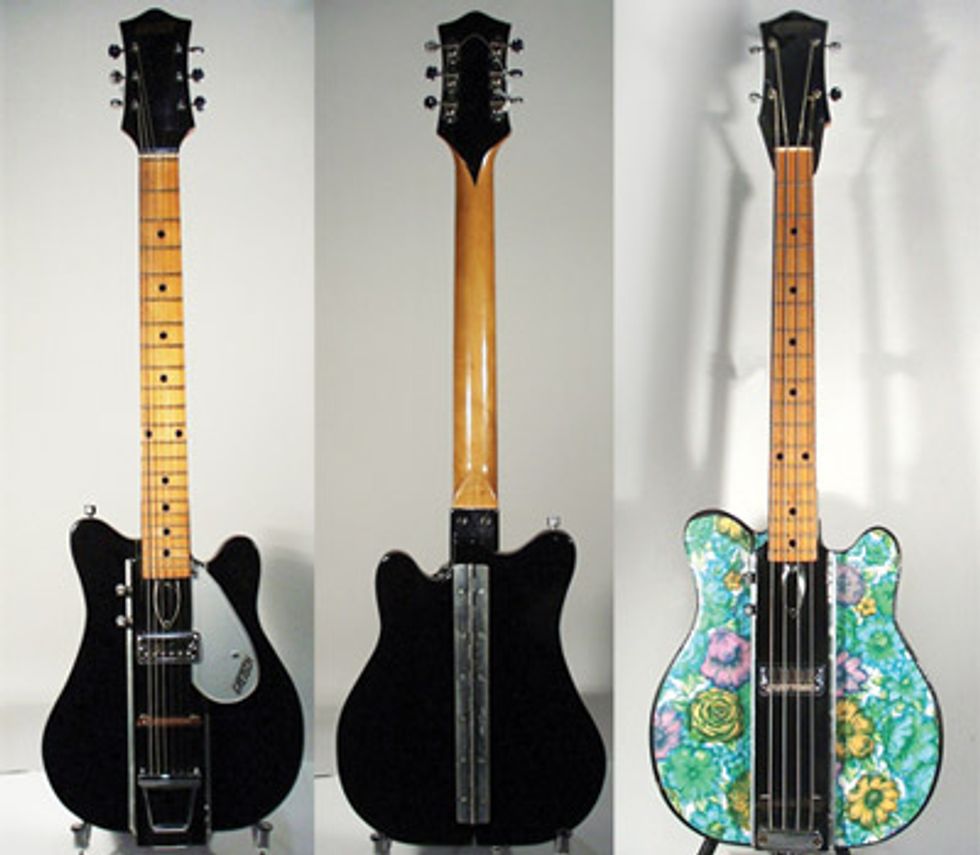
LEFT: Introduced in 1961, the Gretsch Bikini features removable and interchangeable guitar and bass necks rigged with onboard electronics. MIDDLE: To facilitate travel, the Bikini’s body is cut in half and sports a piano hinge on the back, which allows it to be folded when the neck is removed. RIGHT: A swingin’ Bikini configured as a bass. Doubleneck versions were also available.
Hey Zach,
I enjoy your column every month and
I have an oddball guitar I’d like you to
“Trash or Treasure.” It’s the unique and
undeniably cool Gretsch Bikini. I’m a
Gretsch junkie and I bought this guitar
many years ago, but I really don’t
know much of the story behind it.
Why did Gretsch make such a strange
guitar and what is it worth today?
Thanks,
George in Trenton, New Jersey
Hi George,
You’re right, this is definitely an oddball,
but it’s instruments like this that grab our
attention at guitar shows. Gretsch is a relatively
traditional company when it comes
to building guitars, but every now and
then, they throw us a curve. This is evident
with models like the TK 300, Bo Diddley,
Traveling Wilburys, and the Super Axe.
Friedrich Gretsch founded the Fred Gretsch Manufacturing Company and began building instruments in 1883. They offered a variety of instruments through the first half of the 20th Century—including acoustic guitars, banjos, ukuleles, and percussion—but by the early 1950s, Gretsch was dedicating most of its time to the electric Spanish guitar. Several wellknown Gretsch electrics emerged from the 1950s, including the Corvette, Streamliner, Electro II, Country Club, Duo Jet, and the first Gretsch signature guitar—the Chet Atkins model.
Charles Savona, a local New York guitarist, suggested the Bikini concept to Gretsch in 1960. Savona’s design idea was to create a guitar that would fold up and feature interchangeable guitar and bass necks for both versatility and portability. The Bikini production model featured a winged, piano-hinged body referred to as a “butterfly.” The body-mounted, aluminum receiver tracks allowed the “bikini” necks to slide on. Production models from 1961 included a single-neck guitar (Model 6023, $175 MSRP), single-neck bass (Model 6024, $195 MSRP), and a double-neck guitar/ bass (Model 6025, $355 MSRP). The butterfly back could be purchased separately for single- and double-neck models for $25 and $35, respectively.
According to the 1961 Gretsch catalog, “The butterfly back can be used interchangeably with either guitar or bass shafts [necks]. Each instrument can be played separately. With the complete guitar- in-bass ensemble, the double-butterfly back takes both guitar and bass shafts [necks] at the same time—allowing the artist to double on bass without changing instruments!”
The butterfly backs were made of poplar and finished in black lacquer. The bikini necks were constructed of solid maple with an adjustable, steel truss rod that was adjusted at the body-end of the instrument. Electronics included a single Hi-Lo’Tron pickup with volume and tone controls, and an adjustable ebony bridge, trapeze tailpiece, and standard threeper- side tuners completed the hardware. Because every workable part of the guitar was mounted on the bikini neck, the butterfly body was unnecessary for playing— most likely making it similar to playing Les Paul’s infamous Log!
The concept of the Bikini showed merit, especially for the untapped market for portable guitars, but according to Dan Duffy from Gretsch’s quality-control department, “It was a great idea, but in my estimation it wasn’t really engineered correctly.”
The Gretsch factory manager, Bill Hagner, had this to say about the Bikini’s downfall: “You talk about a hard guitar to make, forget about it! Headache! To get that thing on correctly and sliding up and down—it was awful. We didn’t make that many of the Bikini, thank god.” Estimates put the total production of the Bikini at 50 instruments.
While these guitars are rare, they are mostly novelty items to Gretsch collectors and not considered to be players. Today, the Bikini single-neck models are worth between $800 and $1,000 in excellent condition, while double-neck models are worth between $1,800 and $2,250 in excellent condition. In my opinion, this is a treasure to any Gretsch collector who appreciates the company’s oddball offerings!






![Rig Rundown: AFI [2025]](https://www.premierguitar.com/media-library/youtube.jpg?id=62064741&width=1245&height=700&quality=70&coordinates=0%2C0%2C0%2C0)












 Shop Scott's Rig
Shop Scott's Rig















































